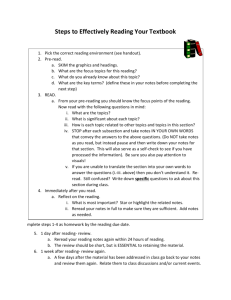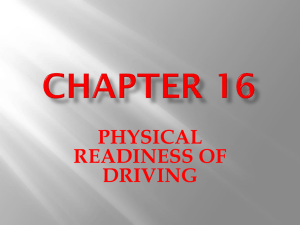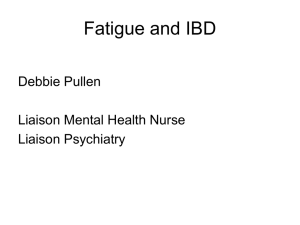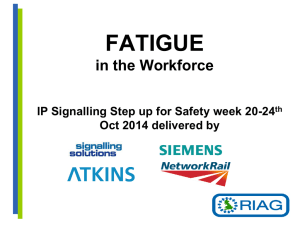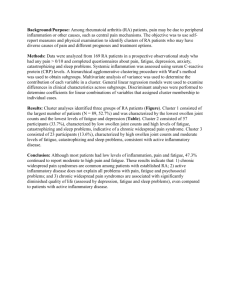Reducing fatigue
advertisement
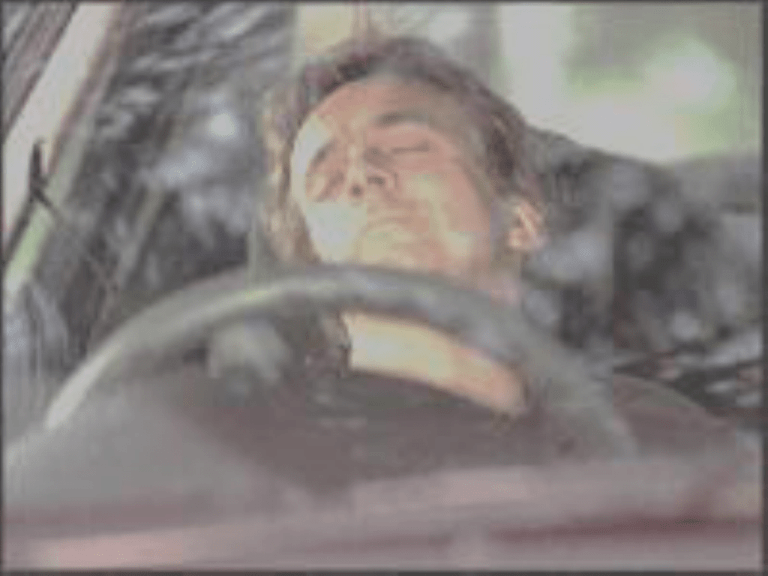
Fatigued Driver Statistics 0 The National Highway Traffic Safety Administration (NHTSA) compiles numerous statistics on driving fatigue accidents. 0 Their records indicate that there are more than 55,000 driving fatigue accidents in the U.S. each year. 0 Even worse, surveys conducted by the National Sleep Foundation show that 60 percent of Americans admit to driving drowsy. Fatigued Driver Statistics 0 Statistics show that both cars and trucks are involved in their share of driving fatigue accidents, but semitruck drivers seem to be particularly at risk. 0 Due to their long hours and packed schedules, big rig drivers are typically on the road for longer than eight hours at a time, which the National Sleep Foundation finds doubles their risk of a truck accident Deaths and Injuries Related to Driver Fatigue 0 According to NHTSA figures, driver fatigue kills 1,550 people each year and contributes to 71,000 driver fatigue injuries. 0 The sad fact is that most of these driving fatigue injuries and deaths could have been prevented if the driver had followed a few safety tips at the first signs of fatigue. 0 In particular, experts at DriverFatigueKills.com and the National Sleep Foundation recommend: 0 • Getting a good night’s sleep 0 • Taking a 15-minute nap if you get tired 0 • Avoiding high-fat meals while driving Cars 0 Many car accidents are also related to driver fatigue. 0 The National Transportation Safety Board estimates that 52 percent of car accidents are caused by driver fatigue. 0 In addition, driving fatigue accidents may account for 30 percent of traffic fatalities. 0 Most traffic safety organizations admit that driver fatigue is an often-overlooked area of traffic safety. 0 While many resources are devoted to drunk driving (which is a significant problem in its own right), driving fatigue gets less attention and fewer resources. What does fatigue mean? 0 Everyone has experienced fatigue at some time. 0 The term is used to describe a range of states or conditions - drowsiness, sleepiness, tiredness, inattention, or exhaustion. 0 Fatigue is the body’s way of reacting to: 0 • lack of sleep; 0 • doing things like working (or driving) at usual sleep times; 0 • long periods of physical or mental exertion; and 0 • some medical conditions and medications. 0 Fatigue is a natural reaction to fairly common situations that people experience in their daily lives such as working under constant pressure, parents looking after young children, or young people missing out on sleep due to frequent late night activities. What does fatigue mean? 0 While less likely, fatigue can also occur despite having adequate sleep or being rested. On a car trip this may be due to driving on long stretches of open road and becoming bored through lack of stimulation, the length of time spent at the wheel, and not taking adequate breaks during a long trip. 0 There is general agreement that three main factors contribute to fatigue: 0 • lack of sleep; 0 • time of day; and 0 • time spent performing a task. Lack of Sleep 0 Without enough sleep an individual will build up a “sleep debt”. 0 Sleep debt is the difference between the amount of sleep needed to maintain alertness and performance, and the actual amount of sleep one has. 0 As little as two hours sleep loss on one occasion can affect reaction time, mental functioning, memory, mood and alertness. 0 A build-up of sleep debt has a much greater effect on reducing alertness and performance, especially on tasks that need constant attention such as driving. Time of Day 0 Humans have a sleep-wake cycle, known as the ‘circadian rhythm’ or ‘body clock’. 0 There are two periods during the 24 hour cycle where the level of sleepiness is high: during the night/early morning, and in the afternoon. 0 During these periods of sleepiness, many functions such as alertness, performance and mood are affected. 0 The effect of the circadian rhythm on road crashes has been shown in a number of studies. 0 These indicate that fatigue related crashes correspond to the 24 hour variation in sleepiness, with a major peak during the night and another peak during mid afternoon. Time Spent on a Task 0 Long periods of activity without rest lead to muscular fatigue. In the same way, prolonged mental workloads without rest will lead to reduced alertness and reluctance to continue the effort. 0 Studies that have looked at driving tasks show that the length of time on a task affects the quality of performance. 0 As more time is spent on a task, the level of fatigue increases, the time to react is slowed, attention and judgment are reduced and the chances of falling asleep during the task are increased. How does fatigue affect safety? 0 A person needs to be alert and focused in order to drive safely for long periods. Fatigue reduces driving skills for a number of reasons: 0 • reactions are much slower; 0 • the ability to concentrate is reduced; and 0 • it takes longer to interpret and understand the traffic situation. How does fatigue affect safety? 0 Many of the effects are similar to those caused by alcohol. 0 Getting behind the wheel after 17 hours without sleep has the same effect on a person’s driving as having a blood alcohol level of 0.05. 0 Further, going without sleep for 24 hours has a similar effect on driving performance as having a blood alcohol concentration of 0.10. 0 At this level the risk of a crash is seven times greater. How does fatigue affect safety? 0 The most common effects of fatigue on actual driving behavior include: 0 • difficulty in keeping the car within a lane; 0 • drifting off the road; 0 • more frequent and unnecessary changes in speed; and 0 • not reacting in time to avoid a dangerous situation (applying the brakes, or turning to avoid an obstacle or fixed roadside object). 0 These failures lead to a high number of single vehicle crashes involving the car striking a tree or other rigid object, and severe head-on collisions. Are some people more likely to be affected? 0 While all drivers can experience fatigue to some degree, fatigue is more likely for people in the following groups, ultimately leading to a higher crash risk: 0 Young People - many young people have lifestyles that involve frequent late night activities, not getting enough sleep, taking risks, and being on the roads during night-time hours. 0 Shift Workers - shift workers are more likely to have disrupted sleep patterns which lead to fatigue more often. Night shift workers have the greatest risk of sleep disruption. 0 People with Sleep Disorders – if left untreated, some conditions such as sleep apnea and insomnia can lead to disrupted sleep on a regular basis. Constantly feeling sleepy can impair the ability to drive safely. 0 Fatigue itself increases crash risk. The risk is much greater with alcohol as even small amounts of alcohol can affect alertness. Fatigue combined with alcohol severely degrades driving skills. Motor Vehicle Crashes 0 No. 1 cause of death 0 An estimated 39,000 to 46,000 people killed in crashes every year 0 More than 2.2 million injuries from crashes in 2008 Distractions now join alcohol and speeding as leading factors in fatal and serious injury crashes. Distracted Driving 0 Driver distractions leading factor in fatal and serious injury crashes 0 In 2008, 28% of all crashes attributable to cell phones 0 1.6 million crashes 0 645,000 injuries 0 Cell phone users 4x as likely to crash Millions of People are Talking While Driving 0 11% of drivers at any point during the day are on cell phones 0 81% of drivers admit to talking on cell phone while driving: 0 74% of Boomers 0 88% of Gen X 0 89% of Gen Y 0 62% of Teen Drivers Millions of People are Texting While Driving 0 18% of drivers admit to texting while driving: 0 4% of Boomers 0 15% of Gen X 0 39% of Gen Y 0 36% of Teen Drivers Driving Culture Change “A century ago, Model T’s brought motoring to an emerging middle class. A half century ago, teenagers cuddled in convertibles at drive-in movies. A new generation of drivers see cars as an extension of their plugged-in lives, with iPods, DVD players and other gadgets.” USA Today, 2-17-2009 Driving Culture Change 0 Webster’s Dictionary named “distracted driving” its 2009 Word of the Year 0 In 2009: 0 More than 200 state bills introduced 0 U.S. DOT Distracted Driving Summit held 0 President Obama signed Executive Order 0 NSC membership survey 0 Favorable public opinion polls How Cell Phones Distract 0 Visual – Eyes off road 0 Mechanical – Hands off wheel 0 Cognitive – Mind off driving CHALLENGE: Drivers don’t understand or realize that talking on a cell phone distracts the brain and takes focus away from the primary task of driving. The Problem 0 Hands-free seen as solution and mistakenly believed to be safer than handheld 0 People recognize the risk of talking on handheld and texting more than the risk of hands-free 0 Most legislation focuses on only handheld devices or texting 0 All state laws and some employer policies allow hands-free devices Hands-free devices offer no safety benefit when driving. The Problem 0 Hands-free seen as solution and mistakenly believed to be safer than handheld 0 People recognize the risk of talking on handheld and texting more than the risk of hands-free 0 Most legislation focuses on only handheld devices or texting 0 All state laws and some employer policies allow hands-free devices Hands-free devices offer no safety benefit when driving. What is a Hands-Free Device? 0 Headset that communicates via wire or wireless connection to cell phone 0 Factory-installed or aftermarket feature built into vehicle (voice recognition) Cognitive Distraction 0 Cognitive distraction still exists with hands- free 0 Talking occurs on both handheld and hands-free cell phones 0 Mind focuses on conversation 0 Listen and respond to disembodied voice Hands-free devices do not eliminate cognitive distraction. Multitasking: A Brain Drain 0 Multitasking for the brain is a myth 0 Human brains do not perform two tasks at same time 0 Brain handles tasks sequentially 0 Brain switches between one task and another The four lobes of the brain. Source: National Institutes of Health Multitasking: A Brain Drain Brain engages in a constant process to: 1. Select information brain will attend to 2. Process information 3. Encode to create memory 4. Store information It must also: 5. Retrieve 6. Execute or act on information When brain is overloaded these steps are affected Multitasking: A Brain Drain Encoding Stage 0 Brain filters information due to overload 0 Drivers not aware of information filtered out 0 Information does not get into memory 0 Drivers miss critical information on potential hazards Inattention blindness and encoding. Source: National Safety Council Multitasking: A Brain Drain 0 Brain juggles tasks, focus and attention 0 Brain switches between primary and secondary tasks 0 Inattention blindness 0 When people do 2 cognitively complex tasks (driving and using a cell phone), causing brain to shift focus 0 Bottleneck 0 Different regions of brain must pull from a shared and limited resource for unrelated tasks Inattention Blindness 0 A type of cognitive distraction 0 “looking” but not “seeing” 0 Hands-free drivers less likely to see: 0 High and low relevant objects 0 Visual cues 0 Exits, red lights and stop signs 0 Navigational signage 0 Content of objects Inattention Blindness A narrowed scope Where drivers not using a hands-free cell phone looked. Where drivers using a hands-free cell phone looked. Source: Transport Canada Multitasking: Impairs Performance 0 Carnegie Mellon University Study (2008) 0 Took fMRI pictures of brain while drivers listened to sentences and drove simulator 0 Literally see the results… Driving alone L Driving with sentence listening R L Functional magnetic resonance imaging images. Source: Carnegie Mellon University R Multitasking: Impairs Performance 0 Just listening to sentences on cell phones decreased activity by 37% in the brain’s parietal lobe which perceives movement, integrates sensory information and also has importance for language processing 0 Listening and language comprehension drew cognitive resources away from driving 0 Also decreased activity in brain’s occipital lobe which processes visual information Multitasking: Impairs Performance 0 We can walk and chew gum safely because it is not a cognitively-demanding task 0 But even cell phone-using pedestrians act unsafely. They are less likely to: 0 Look for traffic before stepping into street 0 Look at traffic while crossing street 0 Notice unusual objects placed along path Multitasking: Impairs Performance 0 Driving involves a more complex set of tasks than walking: 0 Visual 0 Manual 0 Cognitive 0 Auditory 0 A driver’s job is to watch for hazards, but this cannot be done when brain is overloaded Cell Phone: Driver Risks 0 Inattention blindness 0 Slower reaction/response times 0 Problems staying in lane Passenger Conversations 0 Adult passengers share awareness of driving situation, a safety benefit 0 Front seat passengers reduce risk of crashing by 38% compared to cell phone conversations 0 Adults with passengers have lower crash rates than adults without passengers 0 Not true for novice teen drivers Prevention Steps 0 Widespread education 0 Corporate cell phone bans 0 Legislation 0 Law enforcement 0 Technology More than 1.6 million crashes are caused by cell phone use and texting while driving each year. Joe, 12 Bailey, Merideth, Hannah, Sara and Katie Cady, 16 Erica, 9 Jean and Jay, 58 Countless lives have been lost as a result. Linda, 61 Jason, 38 Lauren, 17 Matt, 25 Frances, 13 Jordan, 18 Help us save lives. Tell everyone you know. On the Road, Off the Phone
